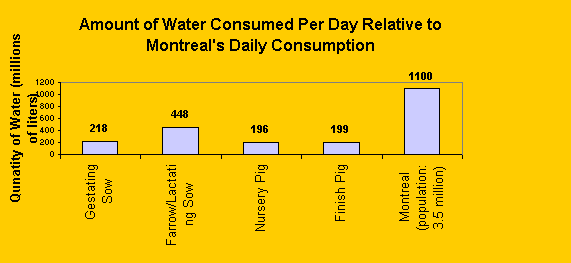When one considers that only 0.007% of all the water on earth is readily accessible for direct use (Environment Canada, 1996), it is important to evaluate the ways in which we distribute the use of our freshwater resources. Since there is a finite amount of water at our disposal, we should attempt to assign a cost to the amount of water used, especially by its primary consumers.
The industrial production of hogs requires a large amount of water for drinking, cleaning facilities, sanitizing equipment, and diluting manure (Kienholz et al., 2000). For the purposes of this assessment, these have been categorized into two main uses: drinking water and flushing water. Drinking and flushing water are considered ‘withdrawal uses’ and are measured as the amount withdrawn from the source for a particular activity over a specific period of time (Environment Canada, 1996). This analysis assumes that minimal quantities of water are reused in hog production facilities. Therefore, all references to quantities of water used pertain to ‘gross water use’ (Environment Canada, 1996). However, the quantity of water consumed by each animals depends largely on physiological and environmental conditions such as age, life stage, temperature, humidity, activity level and water content of the feed (Kienholz et al., 2000). To account for this variability, this analysis will provide a range of water consumption values and water consumption costs, as opposed to a fixed number.
The amount of water consumed for drinking and flushing purposes is presented for four life stages: a gestating sow, a lactating sow, a nursery pig and a finish pig. The total amount of water consumed by individuals in different life ranged from 66.25 to 151.25 liters per hog per day (Table 1).
Table 1: Water consumed for drinking and flushing purposes in liters/ hog/ day by hogs during four physiological life stages from 1Weida, 2000 and 2Kienholz et al, 2000 of Agriculture and Agri-Food Canada.
|
Physiological Life Stage |
Drinking Water [L/H/d] |
Flushing Water1 [L/H/d] |
Average Total Water Consumed [L/H/d] |
| Gestating Sow |
18.751 |
56.25 |
75 |
| Farrow/Lactating Sow |
202 - 26.251 |
131.25 |
154.38 |
| Nursery Pig |
11.251 |
56.25 |
67.5 |
| Finish Pig |
102- 151 |
56.25 |
68.75 |
In order to calculate yearly water consumption by hogs in each life stage (Table 2), the amount of water used on a daily basis per hog was multiplied by the number of hogs in Quebec, which was then multiplied by the number of days in a year. The average Canadian consumes 386 liters of water per day, and the population of Montreal is currently approximately 3.5 million (Statistics Canada, 2000), an estimated 11 billion liters of water are consumed daily. Therefore, the hog industry in Quebec consumes from 18 to 41% of the daily amount of water consumed by the city of Montreal (Figure 1).

The inventory of hogs in Canada
as of January 1st, 1999 was 12.5 million, of which 3.63 million (29%)
are raised in Quebec farms (Statistics Canada, 1999).
Table 2: Total quantity of water consumed by hogs per day and year in Quebec. 1values from Table 1; 2number of hogs housed in industrial farms in Quebec, assumes that all hogs are in the same physiological life stage.
|
Physiological Life Stage |
Water Consumed (L/H/d)1 |
Number of hogs2 (103) |
Total water consumed (103 L/d) |
Total water consumed (103 L/yr) |
| Gestating Sow |
75.00 |
3 630 |
272 250 |
99 371 125 |
| Farrow/Lactating Sow |
154.38 |
3 600 |
555 768 |
200 855 320 |
| Nursery Pig |
67.50 |
3 600 |
243 000 |
88 695 000 |
| Finish Pig |
68.75 |
3 600 |
247 500 |
90 337 500 |
The total annual water consumption by hogs in Quebec was estimated to range from 88.7 billion liters for nursery pigs to 200.1 billion liters for lactating sows (Table 3). To assign a cost to the quantities of water consumed by the hog industry, we used the average municipal water prices for Canada. While most intensive hog production operations are located in rural areas, rural water prices were unavailable for this assessment. The price of tap water, including the cost of waste treatment, in 1992 Canadian dollars, is $0.82 per 1000 liters (Environment Canada, 1996).
Table 3: Total cost of water consumed by hogs per year in Quebec based on value of Canadian currency in 1992.
|
Physiological Life Stage |
Total water consumed (103 L/yr) |
Cost of Water (per 103 L) |
Cost of water ($/yr) |
| Gestating Sow |
99 371 125 |
0.82 |
79 496 900 |
| Farrow/Lactating Sow |
200 855 320 |
0.82 |
160 684 256 |
| Nursery Pig |
88 695 000 |
0.82 |
70 956 000 |
| Finish Pig |
90 337 500 |
0.82 |
72 270 000 |
The annual cost of water consumed for intensive production of hogs in Quebec is estimated to range from 71 to 161 million dollars (Table 3). The estimate is likely conservative because we did not account for fresh water added to manure storage lagoons and the price of water was not corrected for inflation. We were unable to find water prices for rural areas, where the majority of hog industries are located. We were also unable to find water prices for different provinces.